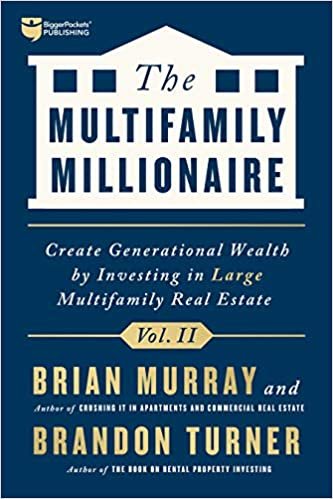The Multifamily Millionaire Vol. II: Achieve Financial Independence by Investing in LARGE Multifamily Real Estate

Physical Copy:
Audiobook:
By: Brandon Turner
Rating: A-
The Bigger Pockets guys are incredibly talented teachers. They have the ability to succinctly explain complex concepts for the average Joe to understand and apply. I try to pick up every book they write that is relevant to my industry.
This book is a crash course in how to invest in commercial multifamily real estate. The sequel to Multifamily Millionaire Vol. 1.
Topics they addressed were:
- Defining your investment criteria
- Structuring multifamily deals
- Syndication
- Raising private capital
- Multifamily debt
- The Lender’s perspective
- The Lending process
- Building your team
- Finding deals
- Screening deals
- Components of Good Underwriting
- Underwriting income
- Underwriting expenses
- Financial analysis
- Making offers and negotiating deals
- Due diligence
- Closing
- Asset Management
- Adding value
- Legal and accounting considerations
- Recession resistance
- Selling your multifamily
My favorite takeaways were:
Chapter 3: Syndication
Fees:
- Acquisition Fee: Typically between 1-4%, with most falling around 2-2.5%.
- Refinance Fee: Based on a % of the mortgage amount at refinance. Typically between 1-3% of the new loan, with most falling around 2-2.5%.
- Loan Guarantee Fee: 1% of the loan amount.
- Asset Management Fee: Monthly management fee based on a % of the project’s gross income. Typically 1-3%, with most falling around 2-2.5%.
- Disposition Fee: Typically 1-4%, with most falling around 2-2.5%.
Chapter 6: The Lender’s Perspective
The lenders need to get comfortable with 3 primary things. BPM: the borrower, the property, and the market.
B - The Borrower: Personal financial strength. Looking for a net worth equal to the size of the loan, and liquidity equal to 10% of the loan amount post-close. Required to submit a personal financial statement (PFS) and schedule of real estate owned (SREO).
P - The Property: They will immediately need the rent roll and historical income and operating expense reports. They look at collection losses, rents versus market rents, criminal activity at the property, and occupancy history.
M - The Market: The location and what’s going on in the environment around it. Demographics and economic factors such as employment trends, housing prices, market rents, and even state and local laws that could affect your investment property.
Chapter 10: Screening Deals
The underwriting process for all deals reviewed:
- Meet initial criteria —> Conduct initial screening
- Pass screening —> Underwrite
- Pass underwriting —> Extend Offer
- Offer accepted —> Due Diligence
- Contingencies fulfilled!
What are your initial criteria?
Type, class, size, age, price, location, Cap rate, Value-add
Screening Attributes:
- Undesirable nearby properties or neighborhood
- Location in a flood zone
- History of violent crime at the property
- Odd floor plans
- Lack of adequate parking
- Rents at or above market
- Declining population
- Lack of job growth
- Onerous landlord-tenant laws
- Low household income
- High crime rates
- Poor school districts
- Low home prices
Chapter 18: Asset Management
Asset Management means managing the property management company, capital expenditures, and the business plan.
The first key to being a good asset manager is to focus on listening to the onsite staff and management company staff.
Ask questions that will facilitate an open dialogue and allow you to learn about any challenges the property manager is facing.
A good Asset Manager will have standing weekly meetings with the property manager. If a property is fully stabilized, meetings can be reduced to biweekly or even monthly, but in the early stages it’s important to stay on top of what’s happening and build a solid relationship.
Asset Management Calls:
- Celebrate wins. Ask the staff to share a win. Put them at ease.
- Review Challenges. Encourage onsite staff to expand on issues so that you can better understand and remove obstacles.
- Assess KPIs. What is the data telling you? Project milestones, Occupancy rate, retention and renewal rates, collections and delinquency, leasing leads, service requests, rent-ready costs.
Chapter 21: Recession Resistance
What are you really afraid of? What constitutes a truly catastrophic situation for a real estate investor?
Most would agree that it would be pretty bad if a property or portfolio stopped cash flowing. The wheels really fall off when you can’t meet your debt obligations.
During recessions your number one goal is to make your future debt payments as low and predictable as you can for the longest period possible.
Here are some red flags to watch out for:
- Debt with high interest rates (relative to current rates)
- Any variable-rate debt
- Fixed rates scheduled to expire in the next three to five years
- Bridge debt (or any other short-term debt instrument)
- Balloon payments
- Full-recourse debt that could be refinanced into nonrecourse debt
- Amortization periods that are shorter than what’s available through a refinance
You can weather many storms if your debt is in control, the entity has adequate cash reserves, and the property is cash flowing.